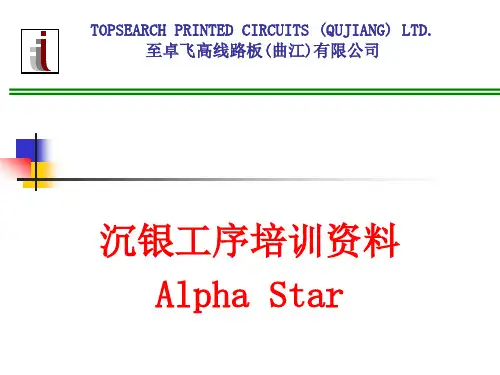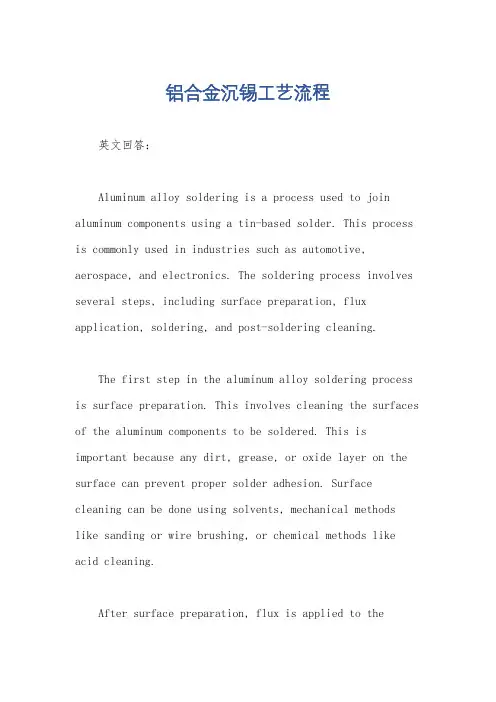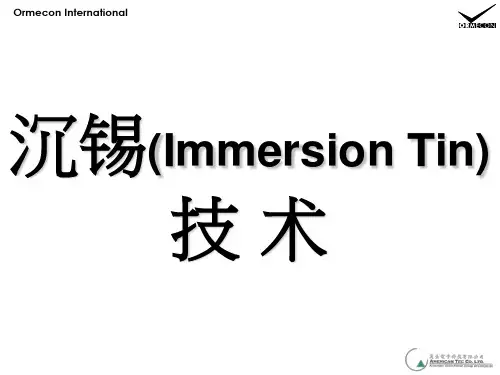Ormecon沉锡资料中文稿
- 格式:ppt
- 大小:6.56 MB
- 文档页数:66




無鉛焊料的合金特性1.介面金屬化學物2.錫鬚介面金屬化合物(IMC)IMC 是Intermetallic compound之縮寫,譯為"介面合金共化物"。
廣義上說是指某些金屬相互緊密接觸之介面間,會產生一種原子遷移互動的行為,組成一層類似合金的"化合物",並可寫出分子式。
在焊接領域的狹義上是指銅錫、金錫、鎳錫及銀錫之間的共化物。
其中尤以銅錫間之良性Cu6Sn5及惡性Cu3Sn最為常見,對焊錫性及焊點可靠度(即焊點強度)兩者影響最大。
介面金屬化學物IMCIMC 在PCB 高溫焊接或錫鉛重熔(即熔錫板或噴錫)時才會發生,有一定的組成及晶體結構,且其生長速度與溫度成正比,常溫中較慢。
一直到出現全鉛的阻絕層(Barrier)才會停止。
此圖為銅面銲點老化後高倍微切片中所看到各層次不同的組成。
IMC 本身具有不良的脆性,將會損及焊點之機械強度及壽命,其中尤其對抗勞強度(Fatigue Strength)危害最烈,且其熔點也較金屬要高。
由於焊錫在介面附近得錫原子會逐漸移走,而與被焊金屬組成IMC,使得該處的錫量減少,使得焊點分子間的內應力發生了變化,以致使焊點固著強度降低,久之甚至帶來整個焊錫體的鬆弛。
一旦焊點商原有的熔錫層或噴錫層,其與底銅之間已出現"較厚"間距過小的IMC 後,對該焊點以後再續作焊接時會有很大的妨礙;也就是在焊錫性(Solder ability)或沾錫性(Wett ability)上都將會出現劣化的情形。
焊點中由於錫銅結晶或錫銀結晶的滲入,使得該焊錫本身的硬度也隨之增加,久之會有脆化的麻煩。
IMC 會隨時老化而逐漸增厚,通常其已長成的厚度,與時間大約形成拋物線的關係,以下為關係式:δ=k․√t,k=k exp(-Q/RT)δ表示t 時間後IMC 已成長的厚度。
K 表示在某一溫度下IMC的生長常數。
T 表示絕對溫度。
R 表示氣體常數,即8.32 J/mole。
Q 表示IMC 生長的活化能。
K=IMC 對時間的生長常數,以nm / √秒或μm/ √日( 1μm / √日=3.4nm / √秒。

深圳亞力盛連接器有限公司SHENZHEN ALEX CONNECTOR CO.,LTD《浸錫基礎知識》培訓教材編審:撰稿:何剑版本:A1 編制日期:2011/2/28目錄一、序言---------------------------------------------------------3二、內容1、浸錫的目的及條件--------------------------------------------42、浸錫材料------------------------------------------------------5-73、浸錫的標准作業----------------------------------------------8-144、浸錫不良的原因及改善對策----------------------------------5-175、浸錫標准判定------------------------------------------------------------18序言浸錫就是將金屬表面沾上一層錫,防止氧化,方便焊接。
是較早應用於連接器行業中的一門技術,浸錫技術即是誰都能夠進行的簡單易做的事情,但它是深邃的。
時至今日浸錫在連接器行業中仍是重中之重,浸錫的好壞直接影響到產品的性能及使用壽命,良好的浸錫能保證產品性能和延長產品使用壽命。
本教材在參考大量的技術圖片和結合浸錫操作需要及本部門對浸錫員實際培訓的基礎上,以標准化操作和人體力學原理為導向,祥細概述了浸錫工站的基本操作手法及注意事項,深入淺出的把浸錫技術中的理論及操作要領描述出來,並以通俗易懂,圖文並茂的形式,讓受訓人員能一目了然,在較短的時間把握焊接要領。
第一章浸錫的目的及條件1.浸錫定義:浸錫就是將金屬表面沾上一層錫,方便下道工序操作。
2.浸錫的目的:1)方便焊接;2)防止氧化;3)把未集中的銅絲全部固定在一起,方便下道工序作業。


铝合金沉锡工艺流程英文回答:Aluminum alloy soldering is a process used to join aluminum components using a tin-based solder. This process is commonly used in industries such as automotive, aerospace, and electronics. The soldering process involves several steps, including surface preparation, flux application, soldering, and post-soldering cleaning.The first step in the aluminum alloy soldering process is surface preparation. This involves cleaning the surfaces of the aluminum components to be soldered. This is important because any dirt, grease, or oxide layer on the surface can prevent proper solder adhesion. Surface cleaning can be done using solvents, mechanical methodslike sanding or wire brushing, or chemical methods like acid cleaning.After surface preparation, flux is applied to thealuminum surfaces. Flux is a chemical compound that helps remove the oxide layer on the surface and promotes solder wetting. It also prevents further oxidation during the soldering process. Flux can be applied using a brush, spray, or by dipping the components into a flux bath.Once the flux is applied, the aluminum components are heated using a soldering iron or a soldering station. The soldering iron is heated to a temperature that issufficient to melt the solder but not too high to cause damage to the aluminum components. The solder is then applied to the joint, and the heat from the soldering iron melts it, creating a bond between the aluminum components.After soldering, it is important to clean the soldered joint to remove any flux residue or excess solder. This can be done using solvents, ultrasonic cleaning, or mechanical methods like brushing. The cleaning process ensures thejoint is free from any contaminants that can affect its performance or appearance.中文回答:铝合金沉锡是一种使用锡基焊料将铝制件连接起来的工艺。

耐蚀合金材料Erosion resistant alloy materials 本公司生产的耐腐蚀镍-铜合金材料,在工业、大气、天然水、高纯水和流动的海水中具有优良的耐蚀性,非氧化的无机酸和大多数有机酸中有一定的耐腐蚀能力,在强碱中耐蚀性能优良。
主要产品是蒙乃尔合金。
The erosion resistant Ni-Cu alloy materials produced by this company enjoy excellent erosion resistance in industry, atmosphere, natural water, highly pure water, flowing seawater and strong alkali; and definite capacity of erosion resistance in the mineral acids of non-oxidation and most of the organic acids. The major product is the monel alloy.主要耐蚀合金材料化学成分:Main chemical components of the erosion resistance alloys主要耐蚀合金性能: Main properties of the erosion resistant alloys型号model熔点melting point(℃)密度density(g/cm3)电阻率resistivity(nΩ.m)Monel 400 1349 8.83 24.1 Monel R-405 1350 8.83 24.1 Monel K-500 1350 8.47 19.6 Monel502 1350 8.44 19.6。



喷锡、熔锡、滚锡、沉锡、银及化学镍金制程术语手册1、Blue Plaque 蓝纹熔锡或喷锡的光亮表面,在高温湿气中一段时间后,常会形成一薄层淡蓝色的钝化层,这是一种锡的氧化物层,称为Blue Plaque。
2、Copper Mirror Test 铜镜试验是一种对助焊剂(Flux)腐蚀性所进行鉴别的试验。
可将液态助焊剂滴在一种特殊的铜镜上(在玻璃上以真空蒸着法涂布500A厚的单面薄铜膜而成),或将锡膏涂上,使其中所含的助焊剂也能与薄铜面接触。
再将此试样放置24 小时,以观察其铜膜是否受到腐蚀,或蚀透的情形( 见IPC-TM-650 之2.3.32节所述)。
此法也可测知其它化学品的腐蚀性如何。
3、Flux 助焊剂是一种在高温下,具有活性的化学品,能将被焊物体表面的氧化物或污化物予以清除,使熔融的焊锡能与洁净的底金属结合而完成焊接。
Flux原来的希腊文是Flow(流动)的意思。
早期是在矿石进行冶金当成"助熔剂",促使熔点降低而达到容易流动的目的。
4、Fused Coating 熔锡层指板面的镀锡铅层,经过高温熔融固化后,会与底层铜面产生"接口合金共化物"层(IMC),而具有更好的焊锡性,以便接纳后续零件脚的焊接。
这种早期所盛行有利于焊锡性所处理的板子,俗称为熔锡板。
5、Fusing Fluid助熔液当"熔锡板"在其红外线重熔(IR Reflow)前,须先用"助熔液"进行助熔处理,此动作类似"助焊处理",故一般非正式的说法也称为助焊剂(Flux)前处理。
事实上"助焊"作用是将铜面氧化物进行清除,而完成焊接式的沾锡,是一种清洁作用。
而上述红外线重熔中的"助熔"作用,却是将红外线受光区与阴影区的温差,藉传热液体予以均匀化,两者功能并不相同。
6、Fusing 熔合是指将各种金属以高温熔融混合,再固化成为合金的方法。
化学沉锡产品说明书CHEMICAL TIN VERTICAL PROCESSREV :2005.06☆ CANADA BAIKAL CHEMICAL INC.☆Table of ContentsProcess Characters工艺特点 (2)Operating Guide操作指导一、Process Sequence流程顺序 (3)二、Final Surface Cleaner表面除油 (4)三、Microetch微蚀 (5)四、Predip预浸 (6)五、Chemical Tin沉锡 (7)六、Post treatment后处理 (10)Process Procedures开缸程序一、Cleaning Process开缸前清洗 (11)二、Start-Up Procedures起动程序 (12)三、Determination of Etch Rate微蚀率测定 (13)四、Simple Solderability Test可焊性简单测试 (14)Operating Parameters操作参数一、Analysis Frequency分析频率 (15)二、Operating Conditions操作条件 (16)三、Replenishment药水补充 (17)Chemical Analysis化学分析一、Final Surface Cleaner除油 (18)二、Microetch微蚀 (19)三、Predip预浸 (20)四、Chemical Tin化学锡 (21)Solderability Test可焊性测试 (22)Result结论 (23)1Process Characters工艺特点1.在155℃下烘烤4小时(即相当于存放一年),或经8天的高温高湿试验(45℃、相对湿度93%),或经三次回流焊后仍具有优良的可焊性;2.沈锡层光滑、平整、致密,比电镀锡难形成铜锡金属互化物,无锡须;3.沉锡层厚度可达0.8-1.5μm,可耐多次无铅焊冲击;4.溶液稳定,工艺简单,可通过分析补充而连续使用,无需换缸;5.既适于垂直工艺也适用于水平工艺;6.沈锡成本远低于沈镍金,与热风整平相当;7.对于喷锡易短路的高密度板有明显的技术优势,适用于细线高密度IC封装的硬板和柔性板;8.适用于表面贴装(SMT)或压合(Press-fit)安装工艺;9.无铅无氟,对环境无污染,免费回收废液。
Sterling Silver A+Sterling Silver B:SGS Job No.12957638 - GZTested Sample Information:货号:175097+175098SGS Internal Reference No.:3.1Date of Sample Received :11 Feb 2011Testing Period :11 Feb 2011 - 15 Feb 2011Test Requested :Selected test(s) as requested by client.Test Method:Please refer to next page(s).Test Results :Please refer to next page(s).Conclusion Based on the performed tests on submitted sample(s), the results comply:with the RoHS Directive 2002/95/EC and its subsequent amendments.Signed for and on behalf ofSGS-CSTC Ltd.Almay GaoApproved SignatoryMDL Limit Result Unit Test Method (Reference)Test Item(s)100Cadmium (Cd)N.D.mg/kg 2IEC 62321:2008, ICP-OES 1000Lead (Pb)N.D.mg/kg 2IEC 62321:2008, ICP-OES 1000Mercury (Hg)N.D.mg/kg 2IEC 62321:2008, ICP-OES 1000Hexavalent Chromium (CrVI) by alkaline extraction N.D.mg/kg2IEC 62321:2008, UV-Vis1000Sum of PBBsN.D.mg/kg --Monobromobiphenyl N.D.mg/kg 5IEC 62321:2008, GC-MS Dibromobiphenyl N.D.mg/kg 5IEC 62321:2008, GC-MS Tribromobiphenyl N.D.mg/kg 5IEC 62321:2008, GC-MS Tetrabromobiphenyl N.D.mg/kg 5IEC 62321:2008, GC-MS Pentabromobiphenyl N.D.mg/kg 5IEC 62321:2008, GC-MS Hexabromobiphenyl N.D.mg/kg 5IEC 62321:2008, GC-MS Heptabromobiphenyl N.D.mg/kg 5IEC 62321:2008, GC-MS Octabromobiphenyl N.D.mg/kg 5IEC 62321:2008, GC-MS Nonabromobiphenyl N.D.mg/kg 5IEC 62321:2008, GC-MS Decabromobiphenyl N.D.mg/kg 5IEC 62321:2008, GC-MS1000Sum of PBDEsN.D.mg/kg --Monobromodiphenyl ether N.D.mg/kg 5IEC 62321:2008, GC-MS Dibromodiphenyl ether N.D.mg/kg 5IEC 62321:2008, GC-MS Tribromodiphenyl ether N.D.mg/kg 5IEC 62321:2008, GC-MS Tetrabromodiphenyl ether N.D.mg/kg 5IEC 62321:2008, GC-MS Pentabromodiphenyl ether N.D.mg/kg 5IEC 62321:2008, GC-MS Hexabromodiphenyl ether N.D.mg/kg 5IEC 62321:2008, GC-MS Heptabromodiphenyl ether N.D.mg/kg 5IEC 62321:2008, GC-MS Octabromodiphenyl ether N.D.mg/kg 5IEC 62321:2008, GC-MS Nonabromodiphenyl ether N.D.mg/kg 5IEC 62321:2008, GC-MS Decabromodiphenyl ether N.D.mg/kg5IEC 62321:2008, GC-MSNote:1. mg/kg = ppm2. N.D. = Not Detected (< MDL)3. MDL = Method Detection Limit4. "-" = Not regulatedRemark : The result(s) shown is/are of the total weight of wet sample.Sample photo:CANEC1100347201CAN11-003472.001SGS authenticate the photo on original report only*** End of Report ***。